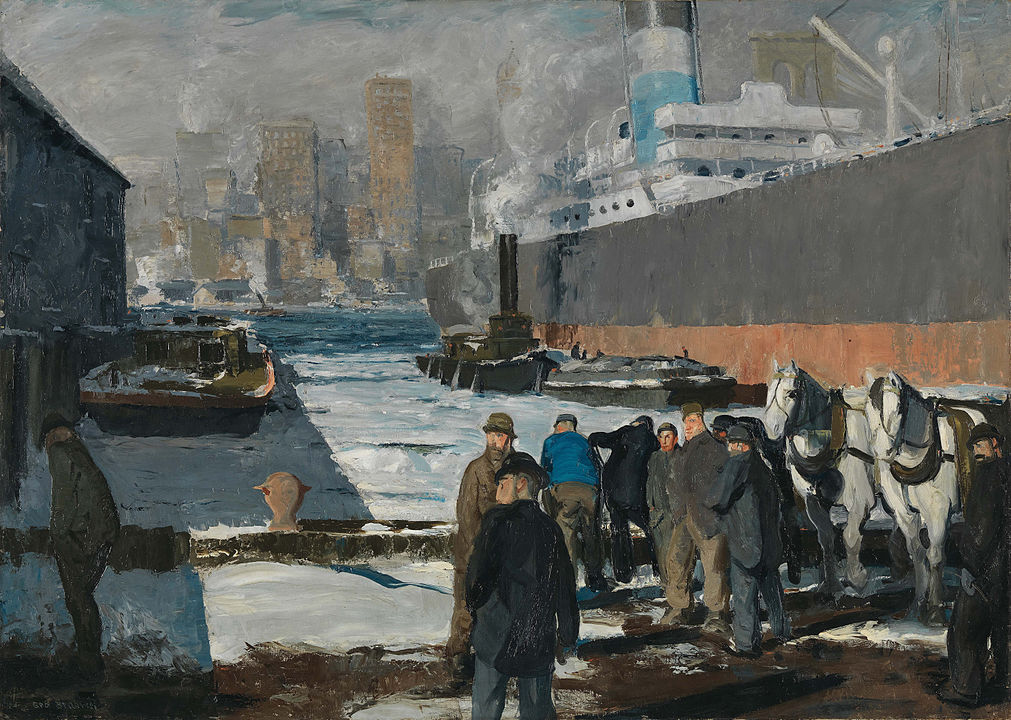
Meaning of George Wesley Bellows’ “Men of the Docks” Painting
In the waning days of the Gilded Age, amid the clash of labor and industry, American painter George Wesley Bellows captured a moment of urban rawness that transcended time. His monumental painting, Men of the Docks, created in 1912, is more than just oil on canvas. It is a testament to the working-class struggle, the rise of American modernism, and the uncertain future faced by a rapidly industrializing world.
Who Was George Wesley Bellows?
George Wesley Bellows (1882–1925) was one of the foremost American realist painters of the early 20th century. Born in Columbus, Ohio, he moved to New York City in 1904, where he studied at the New York School of Art under the tutelage of Robert Henri, a leading figure of the Ashcan School.
The Ashcan School was not a formal movement but a loosely affiliated group of artists who depicted gritty urban scenes, emphasizing realism over romanticism. Bellows, though the youngest member of this circle, quickly rose to prominence through his bold brushwork, mastery of light, and fearless portrayal of city life. His oeuvre spans portraits, boxing matches, and urban landscapes, but none of his works are quite as iconic, or as layered in meaning, as Men of the Docks.
The Context of the Painting
Men of the Docks was painted in 1912, a year brimming with industrial expansion and social unrest. New York was a bustling hub of immigration and economic activity. Longshoremen and dockworkers, many of them immigrants, played a vital role in the economic engine of the city, yet they lived in poverty and uncertainty. Labor unions were still in their infancy, and workers often toiled in brutal conditions with few rights.
Bellows, who lived and worked in New York’s urban core, was acutely aware of these social dynamics. Unlike many artists of his era who romanticized their subjects, Bellows focused on the raw truth. His painting reflects not only the physical strength of the dockworkers but also their existential limbo in a changing America.
The Creation of Men of the Docks
Bellows painted Men of the Docks in his New York studio in 1912. The canvas measures a sizable 114.3 x 161.3 cm (45 x 63.5 inches), giving the composition an imposing presence. Though based on sketches and observations of actual dock scenes in Brooklyn, particularly around the East River, it is not a literal transcription of a single moment. Rather, the painting is a composite, layered with dramatic staging and symbolic intent.
Bellows was known for painting quickly and with immediacy, often working with thick impasto and broad strokes. In Men of the Docks, he uses a subdued yet potent color palette of grays, browns, blues, and whites to evoke the coldness of a winter morning. The brushwork is muscular yet deliberate, with fine attention given to the texture of coats, the grain of the dock, and the churning of the water.
What Is Happening in the Painting?
The painting shows a group of dockworkers, rugged men in heavy coats, standing in clusters on a wooden pier. Some gaze directly at a large steamship in the harbor; others turn to each other, seemingly caught mid-conversation or lost in thought. Behind them looms the industrial skyline of Brooklyn, shrouded in mist and smog. To the right, a large, gleaming white steamship prepares either to dock or depart, its presence dominating the harbor and dwarfing the figures on shore.
There is a palpable tension in the scene. The men appear idle, perhaps waiting for work, or perhaps observing the arrival of cargo that symbolizes both opportunity and burden. The contrast between the stillness of the workers and the potential movement of the ship invites speculation: Are these men at the mercy of economic forces they cannot control? Are they participants in the future, or mere observers?
The Symbolism and Meaning of Men of the Docks
At its heart, Men of the Docks is a meditation on labor, modernity, and alienation.
1. The Workers
The dockworkers are not idealized heroes, nor are they caricatures of despair. Bellows portrays them with dignity but also with a sense of ambiguity. Their hunched postures and expressionless faces suggest a stoic endurance, a quiet resignation to the uncertainties of their labor. They are both essential and expendable, pillars of industry, yet vulnerable to its indifference.
These men represent the backbone of American industrialism, yet they are situated on the literal and metaphorical margins. They are at the edge of the city, the edge of the sea, and the edge of change. In them, Bellows channels the anxiety of a society grappling with mechanization and urban sprawl.
2. The Steamship
The massive white steamship serves as a central symbol in the painting. It embodies the twin forces of modernity and capitalism. Sleek, powerful, and foreign-looking, the vessel appears almost ghostlike against the hazy sky. It could be bringing immigrants, exporting goods, or symbolizing the flow of capital and industry. Its impersonal grandeur contrasts sharply with the individualized, worn humanity of the dockworkers.
The ship also introduces a transatlantic dimension. In 2014, Men of the Docks was acquired by London’s National Gallery, making it the first major American painting to enter the collection. This adds another layer of interpretation: the ship could be seen as a bridge between the Old World and the New, an emblem of America’s growing global influence, and its lingering ties to Europe.
3. The Urban Landscape
In the background, the hazy outlines of factories, cranes, and warehouses form a somber skyline. The air is thick with smog, hinting at environmental degradation and the encroaching dominance of industry over nature. This background is not just a setting, it is a character in its own right, silently asserting the power of the industrial machine.
The docks themselves are a liminal space, neither land nor sea, work nor rest. They are a place of transition, which aligns with the broader theme of social and economic transformation. Bellows doesn’t present an overt critique, but the very ambiguity of the scene invites viewers to ponder the costs of progress.
What Type of Art is Men of the Docks?
Men of the Docks is a hallmark of American Realism, specifically within the tradition of the Ashcan School. Realism as an art movement sought to depict the world as it is, not as it should be. Ashcan artists were especially drawn to the underrepresented: immigrants, laborers, street scenes, and the squalor of urban life.
Bellows pushed this even further. His work combines Realism with elements of Expressionism, his bold, expressive brushwork conveys mood as much as material reality. In this way, Men of the Docks is not just documentary but deeply emotional. It is reportage imbued with resonance.
There is also an echo of Romanticism in the grandeur of the ship and the moody sky, but Bellows undercuts romantic illusions with grounded human presence. Thus, the painting occupies a liminal aesthetic space, realist in content, expressionist in form, and symbolist in meaning.
What Men of the Docks Represents
In essence, Men of the Docks is about waiting, waiting for work, for change, for the future. It encapsulates the tension between man and machine, labor and capital, individuality and anonymity.
Bellows was not a propagandist. He did not paint this scene to make a political point, yet the social commentary is unavoidable. These men are not framed as victims or heroes but as witnesses to a transformation beyond their control. Their presence at the edge of the dock becomes symbolic of America itself, on the brink of industrial dominance, but uncertain about the human cost.
There’s also a timelessness to the painting. Though it was created over a century ago, its themes resonate today. In a world still grappling with automation, migration, labor displacement, and income inequality, Men of the Docks feels as urgent as ever.
Where Is Men of the Docks Today?
Originally part of a private collection, Men of the Docks was acquired in 2014 by the National Gallery in London through a historic transatlantic cultural exchange. The acquisition was made possible through a partnership with the Terra Foundation for American Art. It marked a major milestone for the gallery, being the first major American painting to enter its collection.
Its presence in London, a former capital of empire and a city historically tied to maritime trade, further enriches its interpretation. The dockworkers who once waited at the edges of New York now stand at the heart of European cultural heritage, their story extending beyond national borders to reflect global human concerns.
The Human Face of Modernity
Men of the Docks endures because it is honest. Bellows didn’t flinch from the grayness of modern life. He painted it not with contempt or pity, but with curiosity and compassion. His brush preserved not just a moment in time, but the emotional and social fabric of an era.
This painting stands as a bridge, between the 19th and 20th centuries, between tradition and innovation, between Europe and America, and between art and life. It asks us to look at the men who built the world we live in, and to consider how much, or how little, their lives have changed.
In Men of the Docks, George Bellows gave dignity to the anonymous, strength to the weary, and meaning to the moment between shifts, where history, like the harbor, is never still.




